Ditapis dengan

RASKIN: The Challenge Of Improving Programme Effectiveness
The Rice for the Poor programme (Program Subsidi Beras Bagi Masyarakat Berpendapatan Rendah – hereafter the Raskin programme) is a rice sub sidy initiative implemented nationally, across sectors, both horizon tally and vertically. The programme aims to help low-income families meet their basic food needs and thus increase food security throughout Indonesia. The idea behind Raskin is that hous…
- Edisi
- 1
- ISBN/ISSN
- -
- Deskripsi Fisik
- PDF, 76 Halaman
- Judul Seri
- Textbook dan Ebook
- No. Panggil
- 361.6 TNP r
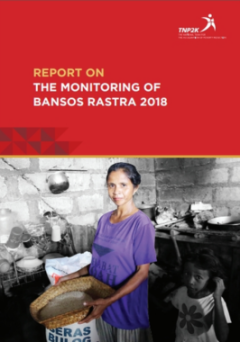
Report On The Monitoring Of Bansos Rastra 2018
To improve the effectiveness and targeting accuracy relating to the implementation of Rastra/Raskin Rice Subsidy Program, the government has stipulated a policy of transforming the Rastra/Raskin Rice Subsidy Program into the Food Social Assistance (Bansos Pangan) Program. In 2017, the Noncash Food Assistance (BPNT) Program was launched in 44 municipalities in replacement of the Rastra/Raskin Su…
- Edisi
- 1
- ISBN/ISSN
- 978-602-275-174-8
- Deskripsi Fisik
- PDF, 54 Halaman
- Judul Seri
- Textbook dan Ebook
- No. Panggil
- 361.2 TNP r

Report On The Second Monitoring Of The Implementation Of The Noncash Food Ass…
The Noncash Food Assistance (BPNT) Program, a transformation of the Welfare Rice Subsidy (Rastra) Program, was launched in the beginning of Fiscal Year 2017 with the target of improving the effectiveness and accuracy of the program as well as promoting inclusive finance. In addition to its transformation from subsidy to social assistance, BPNT also has other reform agenda, including: (1) the tr…
- Edisi
- 1
- ISBN/ISSN
- 978-602-275-188-5
- Deskripsi Fisik
- PDF, 76 Halaman
- Judul Seri
- Textbook dan Ebook
- No. Panggil
- 363.8 TNP r

Report on Pilot Implementation of the 2018 Area Expansion of The Noncash Food…
In compliance with the directions from the President, the Noncash Food Assistance Program (Bantuan Pangan Nontunai, BPNT) has been implemented in the context of reforming the Rastra Rice Subsidy Program. The main objective of such food assistance transformation is to ensure that Family Beneficiaries (Keluarga Penerima Manfaat/KPM) would receive the rice in the correct amount, at the right time …
- Edisi
- 1
- ISBN/ISSN
- 978-602-275-190-8
- Deskripsi Fisik
- PDF, 146 Halaman
- Judul Seri
- Textbook dan Ebook
- No. Panggil
- 363.8 TNP r
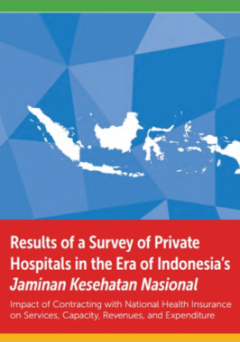
Results Of A Survey Of Private Hospitals In The Era Of Indonesia’s Jaminan …
Indonesia’s national health insurance scheme (Jaminan Kesehatan Nasional or JKN) is a key element of the Government of Indonesia’s (GOI) commitment to ensuring equitable access to healthcare, especially for the poor and the near-poor. JKN’s contracting with private providers was expected to expand reach faster than simply working through the public sector. The single-payer agency for JKN,…
- Edisi
- 1
- ISBN/ISSN
- 978-1-59560-170-4
- Deskripsi Fisik
- PDF, 46 Halaman
- Judul Seri
- Textbook dan Ebook
- No. Panggil
- 362.1068 ROS r
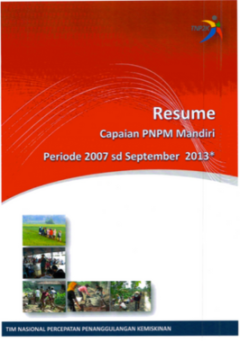
Resume Capaian PNPM Mandiri Periode 2007 sd September 2013
Pelaksanaan program-program penanggulangan kemiskinan berbasis pemberdayaan yang menggunakan pendekatan Community Demand Driven (CDD), yang dimulai sejak tahun 2007, dilaksanakan di seluruh di Indonesia yang meliputi 6,781 Kecamatan dengan 78,582 Desa/Kelurahan yang telah mendapatkan program PNPM Mandiri.
- Edisi
- 1
- ISBN/ISSN
- -
- Deskripsi Fisik
- PDF, 40 Halaman
- Judul Seri
- Textbook dan Hasil Digitalization
- No. Panggil
- 362.5 TNP r
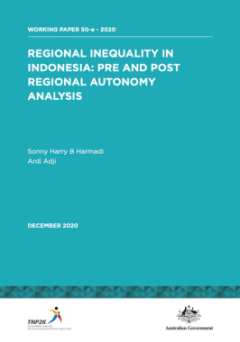
Regional Inequality in Indonesia: Pre And Post Regional Autonomy Analysis
The era of reform in Indonesia was initially triggered by the monetary crisis that Indonesia experienced in June 1997, marked by the sharp decline in the value of the Rupiah, Indonesia’s national currency. In the year 1999, Law No. 22/1999 on Regional Autonomy and then Law No. 25/1999 on Fiscal Balance between the central and regional governments. Both of these laws would later serve as an �…
- Edisi
- Working Paper 50-e - 2020
- ISBN/ISSN
- -
- Deskripsi Fisik
- PDF, 38 Halaman
- Judul Seri
- Working Paper
- No. Panggil
- 320.9598 HAR r

Peraturan Menteri Dalam Negeri Republik Indonesia Nomor 42 Tahun 2010 tentang…
Peraturan Menteri Dalam Negeri Republik Indonesia Nomor 42 Tahun 2010 tentang Tim Koordinasi Penanggulangan Kemiskinan Provinsi dan Kabupaten/Kota memberikan gambaran tentang kebijakan dan struktur koordinasi yang ditetapkan untuk meningkatkan efektivitas penanggulangan kemiskinan di tingkat provinsi dan kabupaten/kota di Indonesia.
- Edisi
- Nomor 42 Tahun 2010
- ISBN/ISSN
- -
- Deskripsi Fisik
- 25 halaman
- Judul Seri
- Textbook
- No. Panggil
- 353.109598 MEN p
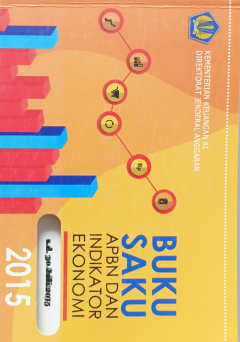
Buku Saku APBN dan Indikator Ekonomi 2015
Buku ini adalah panduan kompak yang menyajikan informasi penting tentang Anggaran Pendapatan dan Belanja Negara (APBN) serta indikator ekonomi utama tahun 2015. Dengan format yang ringkas dan mudah dipahami, pembaca diperkenalkan pada struktur APBN, termasuk pendapatan, belanja, dan defisitnya. Selain itu, buku ini juga merangkum indikator ekonomi makro seperti pertumbuhan ekonomi, inflasi, pen…
- Edisi
- Tahun 2015
- ISBN/ISSN
- -
- Deskripsi Fisik
- Iv + I-6 + II-38 + III-60 + IV-40
- Judul Seri
- Textbook
- No. Panggil
- 352.4809 598 DIR b

Buku Saku APBN dan Indikator Ekonomi 2016
Buku ini merupakan panduan praktis yang menyajikan informasi penting tentang Anggaran Pendapatan dan Belanja Negara (APBN) serta indikator ekonomi kunci tahun 2016. Dengan format yang ringkas dan mudah dipahami, pembaca diperkenalkan pada struktur APBN, termasuk sumber pendapatan, alokasi belanja, dan proyeksi ekonomi nasional. Selain itu, buku ini juga memuat rangkuman tentang indikator ekonom…
- Edisi
- Tahun 2016
- ISBN/ISSN
- -
- Deskripsi Fisik
- Iv + I-6 + II-38 + III-60 + IV-40 halaman
- Judul Seri
- Textbook
- No. Panggil
- 352.4809 598 DIR b

 Karya Umum
Karya Umum  Filsafat
Filsafat  Agama
Agama  Ilmu-ilmu Sosial
Ilmu-ilmu Sosial  Bahasa
Bahasa  Ilmu-ilmu Murni
Ilmu-ilmu Murni 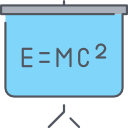 Ilmu-ilmu Terapan
Ilmu-ilmu Terapan  Kesenian, Hiburan, dan Olahraga
Kesenian, Hiburan, dan Olahraga  Kesusastraan
Kesusastraan  Geografi dan Sejarah
Geografi dan Sejarah